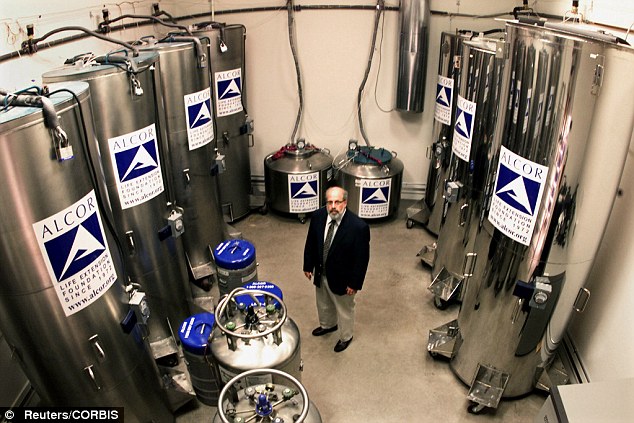


In the heat of Scottsdale, Arizona, time and death are "on pause" for nearly 200 humans cryopreserved in tanks filled with liquid nitrogen. The Alcor Life Extension Foundation, a non-profit, offers cryonic preservation services, freezing deceased individuals at extremely low temperatures in hopes of reviving them in the future. Despite claims of being the world leader in cryonics, the process, which costs hundreds of thousands of dollars, is met with skepticism and ethical concerns. The company's goal is for technology to one day catch up and bring back the "patients" as they were before their death - a controversial concept that has both fascinated and frightened the public.
Live After Death: The Fascinating and Controversial World of Cryonics
Introduction
In the heart of Scottsdale, Arizona, lies a place where time and death are paused for nearly 200 humans. These individuals, cryopreserved in tanks filled with liquid nitrogen, are the patients of the Alcor Life Extension Foundation, a non-profit organization that offers cryonic preservation services.
Cryonics, the process of freezing deceased individuals at extremely low temperatures in the hope of reviving them in the future, is a controversial concept that has both fascinated and frightened the public. Despite claims of being the world leader in this field, Alcor's work is met with skepticism and ethical concerns.
Background
The idea of cryonics originated in the 1960s, when scientists began to speculate that it might be possible to preserve human bodies and brains at temperatures so low that all biological processes would cease. In theory, these bodies could be revived in the future if advances in medical technology made it possible to repair any damage caused by the freezing process.
The first human to be cryopreserved was Dr. James Bedford, a psychology professor who died in 1967. Since then, hundreds of other people have chosen to undergo cryonic preservation, including Robert Ettinger, the founder of the Cryonics Institute, and Ted Williams, the legendary baseball player.
The Cryonic Process
The cryonic preservation process involves several steps:
Scientific and Ethical Concerns
While cryonics is based on sound scientific principles, it is still a highly experimental procedure. There is no guarantee that cryopreserved individuals can be revived in the future, and the long-term effects of freezing on the human body are not fully known.
There are also significant ethical concerns about cryonics. Some critics argue that it is disrespectful of the dead and that it gives false hope to people who are afraid of dying. Others question the wisdom of spending vast sums of money on cryonic preservation when there are so many other pressing human needs.
Top 5 FAQs
1. What are the costs of cryonic preservation?
The cost of cryonic preservation varies depending on the organization and the type of services requested. Alcor Life Extension Foundation offers a basic package for $200,000, which includes transportation to the facility, cooling, perfusion, and storage for 100 years.
2. What are the chances of being revived in the future?
This is impossible to say with certainty. Cryonics is still an experimental procedure, and there is no guarantee that it will be successful. However, Alcor believes that the chances of revival are good, provided that the cryopreserved individual is in good health at the time of death and that the cryonic process is performed correctly.
3. What are the ethical concerns about cryonics?
Critics of cryonics argue that it is disrespectful of the dead and that it gives false hope to people who are afraid of dying. Others question the wisdom of spending vast sums of money on cryonic preservation when there are so many other pressing human needs.
4. What are the scientific challenges facing cryonics?
The main scientific challenges facing cryonics are the prevention of ice crystal formation and the repair of damage caused by the freezing process. Ice crystals can damage cells and tissues, and the freezing process can also cause damage to proteins and lipids.
5. What is the future of cryonics?
The future of cryonics is uncertain. It is possible that advances in medical technology will make it possible to revive cryopreserved individuals in the future. However, it is also possible that cryonics will never be successful. Only time will tell.

In a recent family vlog, Indian celebrity couple Shoaib Ibrahim and Dipika Kakar shared their "natural" hair care routine for their son, using a homemade mask made with rice flour, flax seeds, and coconut oil. However, experts warn that what works for adults may not be suitable for babies, whose sensitive skin and scalp could react to the ingredients. While the ingredients may improve hair texture, they do not necessarily promote hair growth. Instead, a healthy diet and good scalp care are more important in maintaining healthy hair.

A recent consumer study has found multiple brands of soft contact lenses in the U.S. to contain "forever chemicals" that can be harmful to both the body and the environment. The study, conducted by the nonprofit organization Environmental Health Sciences, tested 18 varieties of popular contact lenses and found all of them to contain markers for PFAS. Brands such as Acuvue, Alcon, and CooperVision were among the list of affected products. This news serves as a cautionary lesson on the potential risks of overusing contact lenses.

On the birth anniversary of Dr. APJ Abdul Kalam, the ‘Missile Man’ of India, tributes pour in on social media celebrating his life, vision and impact. A visionary scientist, inspiring leader and true patriot, Dr. Kalam's humility, compassion and constant interaction with students continue to inspire generations. His tireless efforts in defense, science and youth empowerment have strengthened India's path towards self-reliance and his legacy continues to motivate young minds to dream big and work hard for the nation.

Recent studies have found that extreme heat, particularly when combined with high humidity, can have a significant impact on mental health. A study in India showed that when wet bulb temperature exceeded 27°C, the probability of reporting severe depression increased by 0.5%, even when the temperature was slightly lower. This finding is consistent with global reviews that have linked high temperatures to mood disorders, increased hospital admissions for psychiatric conditions, and even elevated suicide risk. The Lancet has also published evidence that rising temperatures worldwide are a growing threat to emotional and cognitive health.

In a meeting with university officials in Udaipur, Rajasthan Governor Hari Bhau Bagde stressed the importance of incorporating India's ancient knowledge traditions into academic research. He highlighted the deep repository of knowledge in India since ancient times and urged scholars and scientists to draw upon this tradition in their work. Bagde also suggested making ancient texts available in university libraries for study and research purposes, in order to shape the intellectual abilities and love for the nation among the younger generation.

John Clarke, Michel H. Devoret, and John M. Martinis have been awarded the 2025 Nobel Prize in Physics for their pioneering research into quantum mechanical tunnelling. Their discovery has opened new possibilities for quantum technologies, and will be formally presented on December 10, the anniversary of Alfred Nobel's death. This announcement follows the tradition of recognizing transformative contributions to science, and the award carries a prestigious prize of 11 million Swedish kronor.

The US-Japanese trio of Mary E Brunkow, Fred Ramsdell, and Shimon Sakaguchi have won the 2025 Nobel Prize in physiology or medicine “for their discoveries concerning peripheral immune tolerance". Through their research, they have shown how the immune system is kept in check and why serious autoimmune diseases do not affect everyone. Sakaguchi found a new class of T cells, while Brunkow and Ramsdell discovered the explanation behind a specific mouse strain's vulnerability to autoimmune diseases. Together, they have significantly advanced our understanding of immunology and autoimmune diseases.

Indian astronaut Shubhanshu Shukla, who recently completed a 20-day space mission, shared his insights and experiences at the convocation ceremony of Dr. APJ Abdul Kalam Technical University. He highlighted the importance of patience, focus, and the inevitability of change in achieving success, and urged the graduating class to actively contribute to shaping a fearless and ambitious India.

The Regional Meteorological Centre (RMC) in Chennai has issued a weather alert for parts of Tamil Nadu, with thunderstorms and light to moderate rainfall expected on Saturday. The alert was issued due to the strengthening of a cyclonic circulation in the Bay of Bengal, which is likely to intensify and form a low-pressure area. The system is expected to affect Tamil Nadu, Puducherry, and Karaikal, with some areas experiencing heavy rainfall and gusty winds. The public is advised to stay updated and take precautions, especially in hilly and western districts.

As a step towards advancing India's deep-sea research capabilities, the Union Science Minister announced a landmark contract with the International Seabed Authority to conduct mineral exploration in the Indian Ocean for the next 15 years. This move will not only help India in expanding its scientific knowledge about the deep sea but also has the potential to strengthen its position as a leading player in the international seabed mining industry.